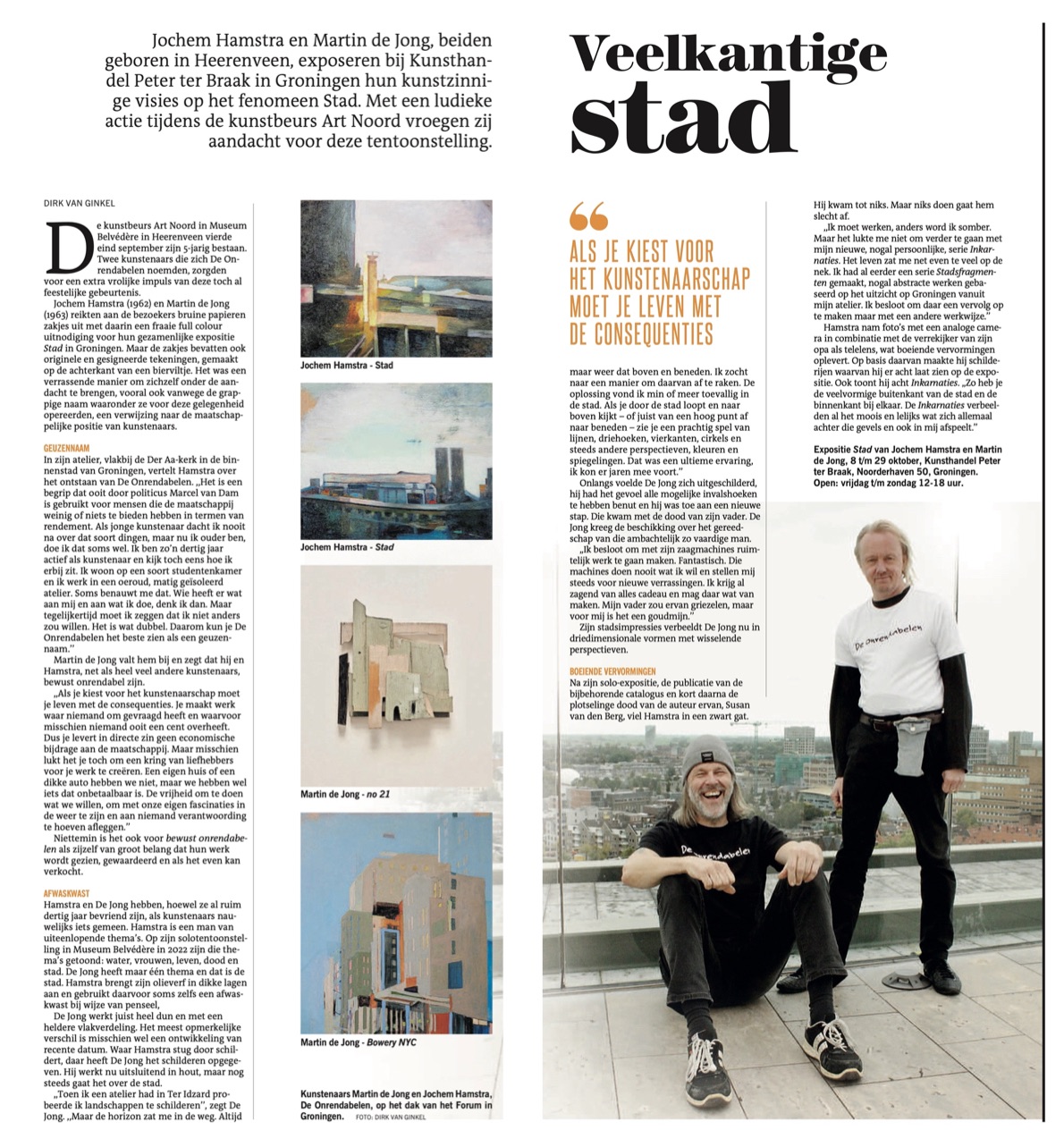Versatile City
Versatile city
Jochem Hamstra and Martin de Jong, both born in Heerenveen, exhibit their artistic sensibilities at Gallery Peter ter Braak in Groningen, views on the City phenomenon. They drew attention to this exhibition with a fun campaign during the Art Noord art fair.
The Art Noord art fair in Museum Belvédère in Heerenveen celebrated its 5th anniversary at the end of September. Two artists who called themselves The Unprofitables provided an extra cheerful boost to this already festive event.
Jochem Hamstra (1962) and Martin de Jong (1963) presented visitors with brown paper bags containing a beautiful full-color invitation to their joint exhibition City in Groningen. But the bags also contain original and signed drawings, made on the back of a beer mat. It was a surprising way to draw attention to themselves, especially because of the funny name under which they operated for this occasion, a reference to the social position of artists.
Nickname
In his studio, in the city center of Groningen, Hamstra talks about the origins of De Onrendabelen. “It is a concept that was once used by politician Marcel van Dam for people who have little or nothing to offer society in terms of returns. As a young artist I never thought about things like that, but now that I’m older I sometimes do. I have been active as an artist for about thirty years and look how I am doing. I live in a kind of student room and I work in an ancient, moderately insulated studio. Sometimes that scares me. Who benefits from me and what I do, I think. But at the same time I have to say that I wouldn’t have it any other way. It’s a bit ambiguous. That is why it is best to view The Unprofitables as a nickname.”
Martin de Jong agrees and says that he and Hamstra, like many other artists, are consciously unprofitable. “If you choose to be an artist, you have to live with the consequences. You make work that no one asked for and for which no one may ever pay a cent. So you make no economic contribution to society in a direct sense. But maybe you will still manage to create a circle of enthusiasts for your work. We don’t have our own house or a fancy car, but we do have something that is unaffordable. The freedom to do what we want, to pursue our own fascinations and not have to be accountable to anyone.”
Nevertheless, it is also very important for consciously unprofitable people like themselves that their work is seen, appreciated and, if possible, sold.
New step
Hamstra and De Jong, although they have been friends for over thirty years, hardly have anything in common as artists. Hamstra is a man of diverse themes. These themes were shown in his solo exhibition at Museum Belvédère in 2022: water, women, life, death and city. De Jong has only one theme and that is the city. Hamstra applies his oil paint in thick layers and sometimes even uses a washing-up brush as a brush.
De Jong works very thinly and with a clear surface division. Perhaps the most notable difference is a recent development. While Hamstra continues to paint stubbornly, De Jong has given up painting. He now works exclusively in wood, but it is still about the city.
“When I had a studio in the country I tried to paint landscapes,” says De Jong. “But the horizon got in my way. Always that above and below. I was looking for a way to get rid of that. I found the solution more or less by chance in the city. If you walk through the city and look up – or down from a high point – you will see a beautiful interplay of lines, triangles, squares, circles and ever different perspectives, colors and reflections. That was an ultimate experience, I could continue with it for years.”
Recently, De Jong felt like he had been painted out, he had the feeling that he had used all possible angles and he was ready for a new step. That came with the death of his father. De Jong was given access to the tools of that skilled man.
“I decided to do spatial work with his sawing machines. Fantastic. Those machines never do what I want and keep presenting me with new surprises. While sawing, I receive all sorts of things as a gift and I get to make something out of them. It would horrify my father, but for me it is a gold mine.”
De Jong now depicts his city impressions in three-dimensional forms with varying perspectives.
